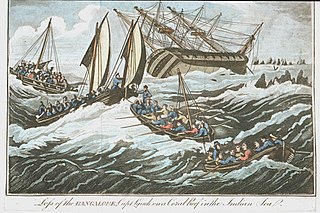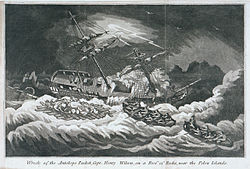
Palau was initially settled around 1000 BC.

George III was a British penal transportation convict ship launched in 1810 in London. She was wrecked while transporting convicts from England to the Australian Colonies. She was wrecked in the southern end of the D'Entrecasteaux Channel, Van Diemen's Land; 134 of the 294 people on board died.

Henry Wilson (1740–1810) was an English naval captain of the British East India Company, from Rotherhithe. He was in command of the British East India Company packet ship Antelope, when it shipwrecked off Ulong Island, near Koror Island in Palau in 1783, and the East Indiaman Warley at the Battle of Pulo Aura.
Tellicherry was a two-decker ship built on the Thames in 1796 in England for John St Barbe, a wealthy merchant and ship owner. She made four voyages as an "extra ship" for the East India Company. Later, she made one trip to Australia transporting convicts. She was wrecked in 1806 in the Philippines.
Chinese have been settling in Palau in small numbers since the 19th century. The early settlers consisted of traders and labourers, and often intermarried with Palauan women. Their offspring quickly assimilated with the local populace and generally identify themselves as Palauan. In recent years, Palau has seen a growing expatriate business community from Taiwan, after Palau established formal diplomatic ties with Taiwan in 1999.

Hindostan was an East Indiaman of the East India Company. She was a large vessel of 1,463 tons (bm), launched in 1796 to replace a previous Hindostan that the Royal Navy had bought and turned into a Fourth Rate ship of the line. Her owner was Robert Williams, M.P., who had been the owner of the previous Hindostan.

The ship Cumberland was launched in 1802 as a 3-decker East Indiaman. She made seven voyages between India and England from 1802 to 1815 for the British East India Company. Her most notable voyage was her second when she fought in the Battle of Pulo Aura against a French squadron. In 1818 the Chilean government arranged for her purchase. When she arrived in Chile the Chileans took her into their navy as San Martín. As part of the First Chilean Navy Squadron she participated in 1818 in the defeat of a Spanish expeditionary force. She was wrecked off the coast of Peru in 1821.

This is a survey of the postage stamps and postal history of Palau.

Ulong is a major island and channel of western Palau. It is sometimes called Aulong and originally written Oroolong in English. Ulong is regarded by many as one of the best drift dives in the world.

Prince Lee Boo or Lebu was the second son of Abba Thulle (Ibedul), the ruler of Koror in the Pelew Islands, now called Palau. Prince Lee Boo was one of the first people from the Pacific Islands to visit Great Britain. When the China trader Antelope, on a voyage to China for the East India Company, was wrecked on the island of Oroolong in Western Palau in 1783, its survivors, including Captain Henry Wilson, spent three months on Palau. When the survivors were finally rescued, Captain Wilson agreed to take Lee Boo to London to acquire more knowledge about Europe. He arrived about a decade after the Tahitian Omai, on 14 July 1784, in Portsmouth, aboard the Morse, and was quickly dubbed "The Black Prince" by London society, who were charmed by his poise and intelligence. The Wilson family took him into their home in London, where he attended church ceremonies, dinner parties and European school for several months. However, he died of smallpox on 27 December 1784, some six months after his arrival in London. He was 20 years old.
Numerous ships have sailed under the name Antelope. Notable ones include:

Nancy was a schooner or ship launched at Bombay. In 1778 the British East India Company (EIC) government at Bengal acquired her to use as a warship at Calcutta. The EIC Board of Governors in London vetoed the idea and Nancy became an express packet ship. She made two voyages from Bengal to Ireland between 1782 and 1784, and was wrecked on the second of these.

The Butterworth Squadron was a British commercial group of three vessels, Butterworth, Jackal, and Prince Lee Boo, that sailed for the Pacific Ocean from London via Cape Horn in late 1791. The principals financing the expedition were Alderman William Curtis, London ship-owner Theophilus Pritzler, and probably John Perry, a Blackwall shipbuilder. The leader of the expedition was Captain William Brown, an established whaling captain from the Greenland whale fishery. Sigismund Bacstrom, a naturalist who had previously sailed as a secretary to Sir Joseph Banks, was the surgeon for the expedition. Bacstrom produced a number of drawings during the first part of the voyage, some of which are still in existence.

Bangalore was built at Calcutta in 1792 and took on British registry in 1797 after having made a voyage from Bengal to London under charter to the British East India Company (EIC). She then traded between London and India. She was wrecked in 1802 in the Flores Sea.
Arran was launched at Calcutta in 1799. In 1800 she sailed to Britain for the British East India Company (EIC). On her return voyage she suffered a major outbreak of illness while between England and the Cape. She then traded between England and India and around India until she was lost in June 1809 while sailing to Basra from Bengal.
Asia was launched at Liverpool in 1798. She competed four voyages for the British East India Company (EIC), and wrecked on her fifth. During the second she transported EIC troops to Macao to augment the Portuguese forces there, but the authorities there refused them permission to land. She was wrecked in 1809 on the outbound leg of a voyage to Madras and Bengal.
Vansittart was launched in 1780 as an East Indiaman. She made three complete voyages for the British East India Company (EIC) and was wrecked in 1789 while outward bound on her way to China on her fourth journey.
Trial was launched at Calcutta as a packet for the British East India Company. She made two voyages to England. In 1782 she narrowly escaped being seized by mutineers. After her return to Calcutta in 1786 she became a pilot schooner for the Bengal Pilot Service. A French privateer captured her in 1797.
Ogle Castle was launched at Cowes in 1821. She made two complete voyages to India sailing under a license from the British East India Company (EIC). She was lost with all aboard on 3 November 1825 while returning to London from her third.
John McCluer was a Scottish hydrographer who rose to the rank of captain in the Bombay Marine. Between 1785 and 1787 he surveyed Muscat and Matruh harbours at the entrance to the Gulf of Oman. In 1787 he was ordered to survey the bank of soundings off Bombay, which he did so thoroughly that his charts remained practically as he left them for nearly seventy years. In 1790 he was appointed to command a small expedition to the Pelew Islands, with the double object of surveying and establishing friendly relations with the natives. He was lost at sea in 1795.
















